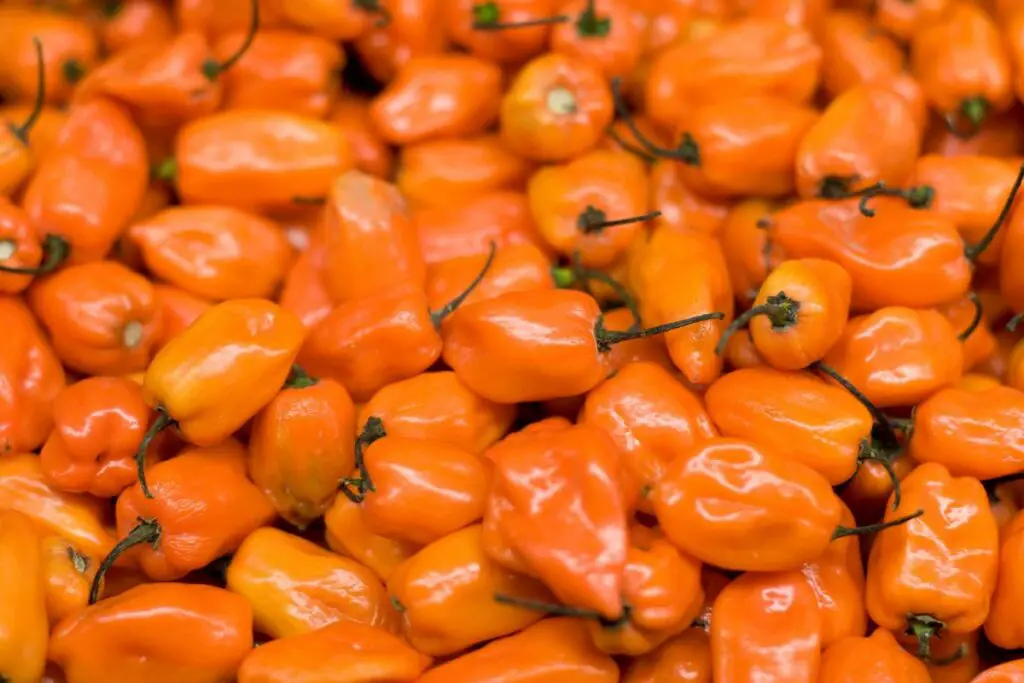They say that variety is the spice of life, but the funny thing is that spices themselves come in plenty of types! The Habanero pepper is found high on the pepper scale at around 150,000 on the Scoville list with an added touch of sweetness.
This pepper is usually green, although you can also find it in the colors yellow, red and orange at various stages of ripeness. This comes with a wonderfully explosive taste, which is due to the citrus in the pepper.
But what if you are sick of the Habanero pepper and you want to find something similar? What if these peppers are all out of stock at the store?
What other breeds of pepper are there that have a similar taste and flavor? Well, let’s take a deep dive into the world of peppers and have a look at 6 of the best Habanero pepper substitutes.

What Are Habanero Peppers?
This type of pepper is a lot smaller, usually measuring around 2 inches in length and being mild to very fiery on the Scoville scale. For comparison, it is significantly hotter than a jalapeno pepper.
This is known to be one of the oldest peppers that you can find in the world. The word Habanero means ‘From Havana’, which is the country of origin of this pepper.
Habanero should only be reserved for those people who really love their spices. You can put it in a curry for that super punch of flavor or you can dice it up for an extra hot spicy
But what if you want to dial down the intensity on one of these peppers? Sometimes they can be a lot to handle, so you might want to opt for a milder pepper instead. Well, let’s have a look at some of the best Habanero substitutes that you can find at your local supermarket.
6 Best Habanero Peppers
1. Scotch Bonnet Peppers
Just looking at this pepper, you might mistake it for a Habanero in terms of size and shape, and it does share some of the same properties. They are small and usually have the color green, which makes them very similar to the jalapeno.
When it comes to the Scoville level, this is found anywhere between 100,000 and 350,000 units, which means they can get significantly hotter than the Habanero. This can often be found in curries and other foods from India, Asia and the Caribbean.
You’ll have to make sure that you have the right protective covering when you are handling these peppers though, as once they get in your eyes they can cause a significant amount of pain.
2. Serrano Peppers
This is a great Habanero substitute for anyone who is looking for a similar taste but with a much lower heat level. They are around 2 inches in length and are green in color, much like the Habanero and the Scotch pepper.
The heat level of a Serrano pepper is generally lower, usually between 5,000 and 15,000 Scoville units. This is great if you want to keep the heat levels low and add a few of them at a time to your curry or salsa sauce.
This is also a crunchy pepper with plenty of flavors, with a lot of people enjoying it purely for the taste. A lot of people actually eat them raw, but they are more commonly used as an ingredient to liven up a dish that might be lacking in spice.
As with a lot of other peppers on our list, the Serrano needs to be handled with extreme care. If you get any of these spices in your eyes, then you can be sure to experience a lot of discomfort.
3. Rocotillo Peppers
This next chili is extremely mild, placed anywhere between 1,500 and 2,500 on the Scoville scale. You can put it in a curry to add some flavor rather than heat.
This is a very crunchy pepper with some earthy textures, which is why a lot of people eat this one raw.
Some people will also dry this pepper out so it can be kept for longer. It contains a lot less capsaicin than other peppers, which means that you can consume quite a lot of them without getting too overheated.
This comes with a very unique taste that can’t entirely be compared to other peppers on this list. It has a much sweeter taste, which is great if you are looking for a primary ingredient for a marinade, chili jam, or rice dish.
You can boil this pepper before cooking, which allows you to remove the skin a lot easier than usual. They are small, which means that it is easy to cook a large batch of them.
4. Jalapeno Peppers
Now, this is a classic pepper that you can find at most supermarkets. You can put it on a lot of different foods such as pizza, and pasta and even bake it into bread.
These are very small peppers, ranging from anywhere between 2 inches and 4 inches long. The most popular form of this pepper is seeing it chopped up into segments. When it reaches full maturity, this pepper will go a deep green color.
There are many different types of Jalapeno pepper, different types ranging between 2,000 and 8,000 Scoville units depending on which one you get.
This is one of the more versatile peppers and can be used to add that little extra zest to soups, salsas, salads, or curries. If you choose Jalapenos that are at the lower end of the spice spectrum, then you can add as many as you like without increasing the heat level too much.
5. Poblano Peppers
This is another pepper that is quite mild on the spice scale, ranging anywhere between 1,000 and 2,500 Scoville units. It is very dark, almost black in color, which indicates how ripe it is.
This plant is cultivated in New Mexico and makes up for over a quarter of the chili revenue from this area. Poblano is usually made into a powder and is then added to various dishes.
It has a nutty undertone, which is what makes it so distinctive in terms of flavor.
This pepper comes with a very thin skin, which makes it great for cooking. You can peel it quite easily and add the insides to a wide number of dishes.
6. Aleppo Peppers
Finally, we have a moderate pepper that rates about 10,000 on the Scoville scale. It is a burgundy-colored pepper, which often results in a burgundy color of powder when it is ground down.
This pepper has been known to have a very fruity undertaste, with hints of cumin and nuts.
This pepper has a vibrant history. It is named after the Syrian city of Aleppo and is still grown in the regions of Syria and Turkey.
This does not contain any seeds, which is why it is a lot milder than some of the other peppers that we have on this list. It has been said to have a similar scent to sundried tomatoes, which is often what is said to taste like.
Frequently Asked Questions
Why Would I Need A Habanero Pepper Substitute?
What Foods Go Well With Peppers?
How Can You Reduce The Heat Of A Pepper?
What Determines How Hot A Pepper Can Get?
If you want to try and take out some of the heat of the pepper, then you can always scoop out the seeds. This sometimes works with the jalapeno pepper.
Conclusion
We hope that these Habanero substitutes have helped you decide which ones you feel might be the most appropriate to replace this mild pepper.
Remember that these peppers are on the mid-range of the Scoville scale, so make sure you protect your eyes and hands when handling them.
6 Great Habanero Pepper Substitutes – Get Cooking Right Now!
Course: Substitutes4
servings30
minutes40
minutes300
kcalSubstitutes
Scotch Bonnet Peppers
Serrano Peppers
Rocotillo Peppers
Jalapeno Peppers
Poblano Peppers
Aleppo Peppers
Directions
- Pick a substitute from the list above
- Decide on what substitute you need
- Read what you need to substitute with
- Create the recipe and enjoy
- What Exactly Do Chickpeas Taste Like? Is There A Distinct Flavor? - September 30, 2023
- Top 11 Low Carb Options at Sonic Drive-In for Keto Diet - September 30, 2023
- What Should You Serve Alongside Potato Salad? 8 Incredible Side Dishes - September 30, 2023











